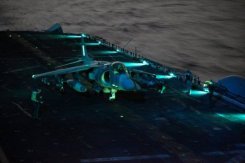 |
| US Navy handout image shows a Harrier jet upon return to the amphibious assault ship USS Kearsarge in March © AFP/USMC/NVNS/File Lance Cpl. Michael S. Lockett |
WASHINGTON (AFP) – Advocates of US air power are seizing on the outcome of the NATO campaign in Libya as further evidence that high-tech aircraft are the key to maintaining US military might.
With its relatively low price tag and short duration, the Libya conflict offers a stark contrast to the protracted and costly ground wars in Iraq and Afghanistan that have left Americans wary of counter-insurgency campaigns.
“The recent record of air power is generally perceived by the public as being shiny,” said Stephen Biddle, a senior fellow at the Council on Foreign Relations.
“Whereas the recent record for ground warfare, even when it’s thought to have been successful, is generally seen as expensive, high-casualty and slow. The Libyan campaign just tends to accentuate all those perceptions.”
 |
| Ad |
With the US defense budget coming under growing pressure, the Air Force and its supporters — including the powerful aerospace industry — cite the Libya campaign as yet more ammunition for their arguments in favor of major investments in new fighters, bombers, tankers and drones.
Allied aircraft knocked out Libya’s air defenses, imposed a no-fly zone that grounded Moamer Kadhafi’s air force and crippled his army’s tanks and heavy weapons, enabling a fledgling rebel force to eventually prevail and topple the dictator’s regime, said David Deptula, a retired Air Force general.
“In other words, modern air power eliminated the effectiveness of the Libyan army and provided the weakly organized and poorly equipped Kadhafi opponents the ability to defeat his loyalist army,” he said.
Deptula, who served as Air Force deputy chief of staff for intelligence, surveillance and reconnaissance, argues that if America wants to retain its military edge around the world, it has to ensure that United States enjoys “air dominance.”
From humanitarian relief operations to potential regional conflicts or even global war, air power is the crucial underlying factor that helps make the United States the “world’s sole superpower,” he told AFP.
“It makes sense to continue investment in what essentially is the linchpin of our national security strategy,” said Deptula, who now works for a defense contractor.
As the armed services vie for a share of the defense budget, President Barack Obama’s has signaled a strategic shift to the Asia-Pacific region. That focus plays to the strengths of the Air Force as well as the Navy at the expense of the Army, as planes and aircraft carriers can “project” US power over vast distances.
War strategy and aviation technology also has evolved since the end of the Cold War, heightening the importance of air power and eliminating the need to build up vast armored divisions trained for large-scale tank battles in open terrain.
“The idea that we’re going to engage in three kilometer tank duels — why would we bother? If they (enemy tanks) are in the desert, in the open, the Air Force is probably going to lacerate them and when the Air Force can’t get them, it will often be because they’re in forests, or towns, or other places where the ranges will be a lot shorter than three kilometers,” Biddle said.
The Libya conflict has renewed the idea of the “small footprint,” relying on highly-trained special operations forces working with local fighters backed up by aircraft to achieve quick results — without being sucked into a drawn-out ground war.
The Libya war “reinforces the sentiment that was already there post Iraq against boots on the ground and long-term commitments of nation-building,” said author Peter Singer, a senior fellow at the Brookings Institution.
But analysts warn that the “Afghan model,” named for the operation that swiftly toppled the Taliban regime in 2001, offers no guarantees and requires indigenous forces that are sufficiently capable to wage war.
“If it’s going to move fast, it’s going to require an ally that has some skill before you show up,” Biddle said.
US Army leaders, worried about deep cuts in troop numbers, argue the “Afghan model” is unrealistic and that the country needs a large ground force to prevail in any major war.
Even with billions likely to flow to new aircraft, the Air Force faces tough questions over the new F-35 fighter, which has been billed as the backbone of the future fleet but has been plagued by incessant delays and cost overruns.
The budget crunch may mean buying fewer of the Joint Strike Fighters or even eliminating a short-takeoff model coveted by the US Marine Corps.
The Pentagon and Congress also will have to balance calls for more traditional, manned aircraft such as the F-35 fighter with demands for more advanced, lethal drones, which have become the weapon of choice for covert counter-terror strikes.
© AFP — Published at Activist Post with license
linkwithin_text=’Related Articles:’


Be the first to comment on "Libya war gives US air power advocates a lift"